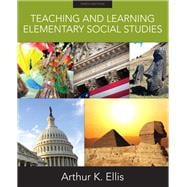
Note: Supplemental materials are not guaranteed with Rental or Used book purchases.
Purchase Benefits
What is included with this book?
Preface
Introduction
Chapter 1: Social Studies: Definitions and Rationale
The Excitement and Wonder of the Quest
The Meaning of Social Studies
A Rationale
Social Studies Curriculum Patterns
Widening Horizons
The Spiral Curriculum
An Environment for Social Studies Learning
Increased Learner Independence
Differences among Learners
The Roles of the Teacher
Summary
Continue the Journey
Suggested Readings
Chapter 2: Children in a Democracy: Teaching & Learning Responsible Citizenship
Citizenship and Civic Education
The Citizen’s Role in a Democracy
Becoming Active Citizens
Engagement and Participation
A Sense of Community
Effective Citizenship
Nurturing Young Citizens
Perspective Taking
The Meaning of Citizenship
Summary
Continue the Journey
Suggested Readings
Chapter 3: Social Studies and Diversity in America
Diversity in the United States and in the Classroom
The Role of Social Studies Education in Promoting Pluralism and Diversity
Cultural Sensitivity in Social Studies Curricula
Creating a Culturally Responsive Learning Environment
The Teacher’s Cultural Sensitivity
Preparing Children for a Diverse World
Summary
Continue the Journey
Suggested Readings
Chapter 4: Setting and Achieving Social Studies Standards
Content and Performance Standards
The Nature of Knowledge
Knowledge Received
Knowledge Discovered
Knowledge Constructed
The National Council for the Social Studies Standards as Guide
What Should Children Know and Be Able to Do?
The Social Science Disciplines
Summary
Continue the Journey
Suggested Readings
Chapter 5: Three Ways to Center the Social Studies Curriculum: Knowledge, the Learner, & Society
The Learner-Centered Approach
The Society-Centered Approach
The Knowledge-Centered Approach
Finding the Balance
Summary
Continue the Journey
Suggested Readings
Chpater 6: Planning for Social Studies Teaching & Learning
Planning with Standards in Mind
Teachers as Decision Makers
Planning Lessons and Activities
Teaching Concepts, Skills, and Values
Unit Planning
Developing a Unit Plan
Summary
Continue the Journey
Suggested Readings
Chapter 7: Successful Strategies for Social Studies Teaching & Learning
Five Principles of Effective Teaching and Learning
Direct Instruction Strategies
Teacher Presentation
Class Discussion
Demonstration
Observations on Direct Instruction
Indirect Instruction Strategies
Role Play
Interest Centers
Group Investigations and Projects
Reflective Thinking
Creative Expression
Content Analysis
Differentiated Assignments
Jigsaw-Peer Teaching
Simulations
Observations on Direct Instruction
Summary
Continue the Journey
Suggested Readings
Chapter 8: Assessing Social Studies Learning
An Overview of Assessment
Why Assess?
What to Assess?
How to Assess?
Integrated Assessment Strategies
Portfolio Assessment
Assessing Your Own Effectiveness
Standards and Achievement
Summary
Continue the Journey
Standards and Achievement
Chapter 9: Inquiry, Discovery, & Problem Solving: Children as Researchers
Inquiry, Discovery, and Problem Solving
Types of Inquiry Research
Historical Research
Descriptive Research
Survey Research
Experimental Research
Assessment and Inquiry
Metacognition and Inquiry
Summary
Continue the Journey
Suggested Readings
Chapter 10: Social Studies and the Integrated Curriculum
What Is Integration?
Connecting Learning
Groups and Individuals
Projects as the building Blocks of Integrated Studies
Characteristics of Good Projects
Group and Individual Projects
Kinds of Projects
All Things Are Connected
Summary
Continue the Journey
Suggested Readings
Chapter 11: Exploring Our Geographic world
The Tools of Geography
The Five Themes of Geography
Helping Students Learn to Make and Read Maps
Mental Maps
Traverse Maps
Aerial Photographs and Maps
Changing the Scale of a Map
Understanding Map Projections and Globes
Helping Students Learn to Use Maps
Finding Your Way
Changes in Land Use
Understanding Perspective
Estimating Distances
Maps in an Internet Connected Era
Summary
Continue the Journey
Suggested Readings
Chapter 12
Making History Come Alive
The Nature of History
Why Should Young People Study History?
The Power of Storytelling as History
Biographies
Historical Fiction
Using Historical Sources
Children as Historians
Oral Histories
Personal Histories
Time Lines
Experiential History Activities
Summary
Continue the Journey
Suggested Readings
Chapter 13: Social Studies and the Literacy Connection
Toward a Literate Society
Literacy and Democracy
Reading and Writing
Experience and Discussion
Social Studies and Language Development
Interpreting Text
Journal Writing
The Writing Process
The Spoken Word
Public Speaking
Small-Group Speaking
Informal Talks
Group Presentations
Media and Electronic Literacy
Summary
Continue the Journey
Suggested Readings
Epilogue
The Importance of Experiential Learning
How Reflective Thought Develops
Constructivism and Social Studies
Strategies for Improving Learning
Crossing the Frontier to Active Learning
Suggested Readings
The New copy of this book will include any supplemental materials advertised. Please check the title of the book to determine if it should include any access cards, study guides, lab manuals, CDs, etc.
The Used, Rental and eBook copies of this book are not guaranteed to include any supplemental materials. Typically, only the book itself is included. This is true even if the title states it includes any access cards, study guides, lab manuals, CDs, etc.